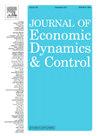所有的模型都是错误的,但都是有用的:使用预测池的稳健策略设计
IF 2.3
3区 经济学
Q2 ECONOMICS
引用次数: 0
摘要
我们使用一种新颖的方法研究了对不确定性模型稳健的货币政策规则的设计。在我们的应用中,决策者通过对一组具有不同金融摩擦的成熟DSGE模型附加权重来选择最优规则。我们的方法的新颖之处在于根据每个模型的相对预测性能来计算它们的权重。我们的结果突出了预测池相对于贝叶斯模型平均的优越性,以及当没有一个模型可以被视为真正的数据生成过程时,需要将模型组合起来。此外,我们发现最优的跨模型鲁棒策略规则呈现衰减,并嵌套一个具有良好鲁棒性的价格水平规则。因此,我们的方法的应用为价格水平规则提供了一个新的基本原理,即金融摩擦性质不确定性的存在。本文章由计算机程序翻译,如有差异,请以英文原文为准。
All models are wrong but all can be useful: Robust policy design using prediction pools
We study the design of monetary policy rules robust to model uncertainty using a novel methodology. In our application, policymakers choose the optimal rule by attaching weights to a set of well-established DSGE models with varied financial frictions. The novelty of our methodology is to compute each model's weight based on their relative forecasting performance. Our results highlight the superiority of predictive pools over Bayesian model averaging and the need to combine models when none can be deemed as the true data generating process. In addition, we find that the optimal across-model robust policy rule exhibits attenuation, and nests a price level rule which has good robustness properties. Therefore, the application of our methodology offers a new rationale for price-level rules, namely the presence of uncertainty over the nature of financial frictions.
求助全文
通过发布文献求助,成功后即可免费获取论文全文。
去求助
来源期刊

Journal of Economic Dynamics & Control
ECONOMICS-
CiteScore
3.10
自引率
10.50%
发文量
199
期刊介绍:
The journal provides an outlet for publication of research concerning all theoretical and empirical aspects of economic dynamics and control as well as the development and use of computational methods in economics and finance. Contributions regarding computational methods may include, but are not restricted to, artificial intelligence, databases, decision support systems, genetic algorithms, modelling languages, neural networks, numerical algorithms for optimization, control and equilibria, parallel computing and qualitative reasoning.
 求助内容:
求助内容: 应助结果提醒方式:
应助结果提醒方式:


